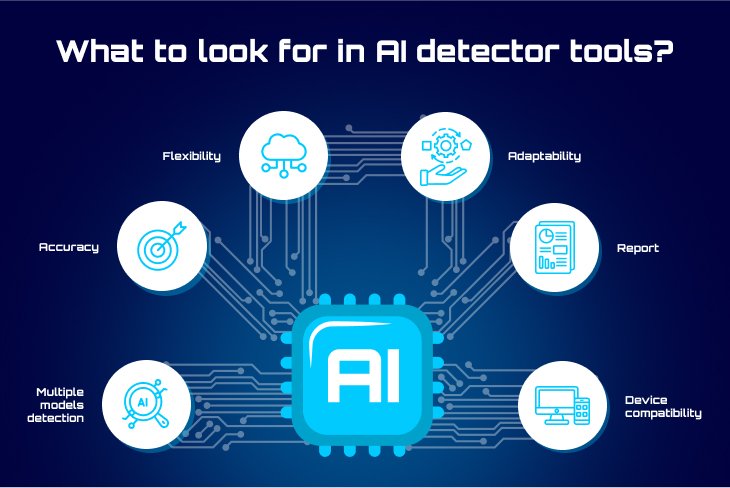What to look for in AI detector tools?

The AI detector tools easily recognize AI-generated content by analyzing patterns in the text, certain words and phrases, the length of the sentences, etc. There are numerous AI detector tools available in the market. Thus, it’s important to consider the given points and select the right tool to use.
- Multiple models detection: AI-generated text developed in GPT-3, GPT-4, Bard, and other models should be detectable.
- Accuracy: The ideal AI checker should have few instances of false positives or negatives and provide fairly dependable outcomes.
- Flexibility: It should be able to evaluate big datasets without losing accuracy.
- Adaptability: The AI detector should allow you to tailor the analysis process to focus on specific criteria that match your requirements.
- Report: The AI checker needs to provide you with a summary of your past research and enable you to spot patterns that can encourage you to produce better content.
- Device compatibility: It should operate flawlessly across a variety of devices and operating systems.
Which are the best AI detector tools?
ZeroGPT
It is one of the most convenient and simple AI detector tools available. Furthermore, there are several benefits of using it. Not only does the detection of the content but it also allows you to generate content, paraphrase the content, and more. Additionally, it is compatible with various languages like German, English, Hindi, French, etc. Thus, it is helpful for institutions all around the world.
Whenever you can a copy, you will be able to see the percentage of content written using AI or not. The only reason that people won’t like the interface as it is a little old-fashioned.
Crossplag
Crossplag is a plagiarism-spotting software. One of its more recent capabilities is the AI text detector, which uses artificial intelligence algorithms to reliably identify the source of a document and determine whether it is AI or human-generated.
The AI checker is taught to identify sequences in human-written texts. Crossplag detects breaks from these sequences and shows percentages that indicate the likelihood of your content being generated by AI.
Copyleaks
Copyleaks analyzes texts phrase by sentence, providing exact information on which sections were authored by humans and which are potentially AI-generated content. Copyleaks knows 30 languages, making it an ideal tool for global companies. Additionally, it can evaluate source code, making it an excellent choice for software creation and programming teams.
Winston AI
Winston AI presently supports the English, Spanish, German, and French languages. The platform accepts a variety of file kinds, including docx, jpg, and png files. Aside from indicating the broad likelihood that a text contains AI-generated information, Winston AI provides a sentence-by-sentence evaluation, allowing you to go deeper and identify problematic regions.
GLTR
GLTR is also one of the AI detector tools created by Watson AI Lab and Harvard NLP. It allows you to perform a test on a text to identify whether AI-generated it. Based on GPT-2 technology, the tool examines each phrase to determine how probable AI would anticipate it. It accomplishes this by concentrating on the context before the phrase in the issue and the likelihood that AI will create a given sequence of words.
Originality.ai
Originality.ai is also one of the AI detector tools that combines an AI checker with a plagiarism checker. It can detect content generated from GPT-3, GPT 4, Bard, etc. with high precision.
Originality.ai is great for teams, owing to its creative alternatives like adding coworkers to the site, checking scan history, and sharing findings. While content marketing and SEO businesses are its main target audience, anybody who wants to make sure their material is free of artificial intelligence (AI) may utilize it.
Content at Scale
Content at Scale’s AI detector provides a simple, no-frills approach to evaluate a text and identify whether it was written by humans, AI, or a combination of the two. When you conduct the analysis, the tool colors your content to show which sections were most likely created by AI and which were composed by humans.
Conclusion
As we include these AI detector tools in our systems, we must be mindful of their capabilities, limitations, and ethical consequences. The relentless pursuit of innovation must be matched with a commitment to responsible AI usage, which guarantees that new technologies are utilized properly and to the greatest benefit.

